[MM] Making LLaMA SEE and Draw with SEED Tokenizer
[MM] Making LLaMA SEE and Draw with SEED Tokenizer
- paper: https://arxiv.org/abs/2310.01218
- github: https://github.com/AILab-CVC/SEED
- ICLR 2024 accepted (인용수: 43회, ‘24-09-11 기준)
- downstream task: Image Captioning, Image/Video Question & Answering (Multi-modal understading & reasoning), Text-to-Image Generation (Multimodal generation)
1. Motivation
-
최근 MLLM은 multi-modal comprehension & generation task를 통합하는데 어려움을 겪고 있음
-
이는 LLM의 입력으로 들어가는 Image token이 text token과 다른 점들이 있기 때문
-
Image token은 독립된 2D patch position간의 bi-directional attention을 통해 학습함으로써 상호 종속되게 (inter-dependence) 학습됨
- 반면, Text token은 1D left-to-right causal attention을 통해 학습이 됨
-
Image token은 low-level semantic (색, edge, 등)을 보유한 반면 Text token은 “단어” 기반으로 high-level semantic을 보존함
-
Image token은 continuous 값인데 비해, text token은 discretized된 codebook에서 뽑아옴
$\to$ semantic level을 맞추고, discretized codebook을 사용하며, 1D rasterized order로 예측을 수행하는 visual tokenizer를 만들어 LLM 학습에 사용한 목적 함수 (Next-word prediction) 그대로 학습하면 훨씬 좋지 않을까?
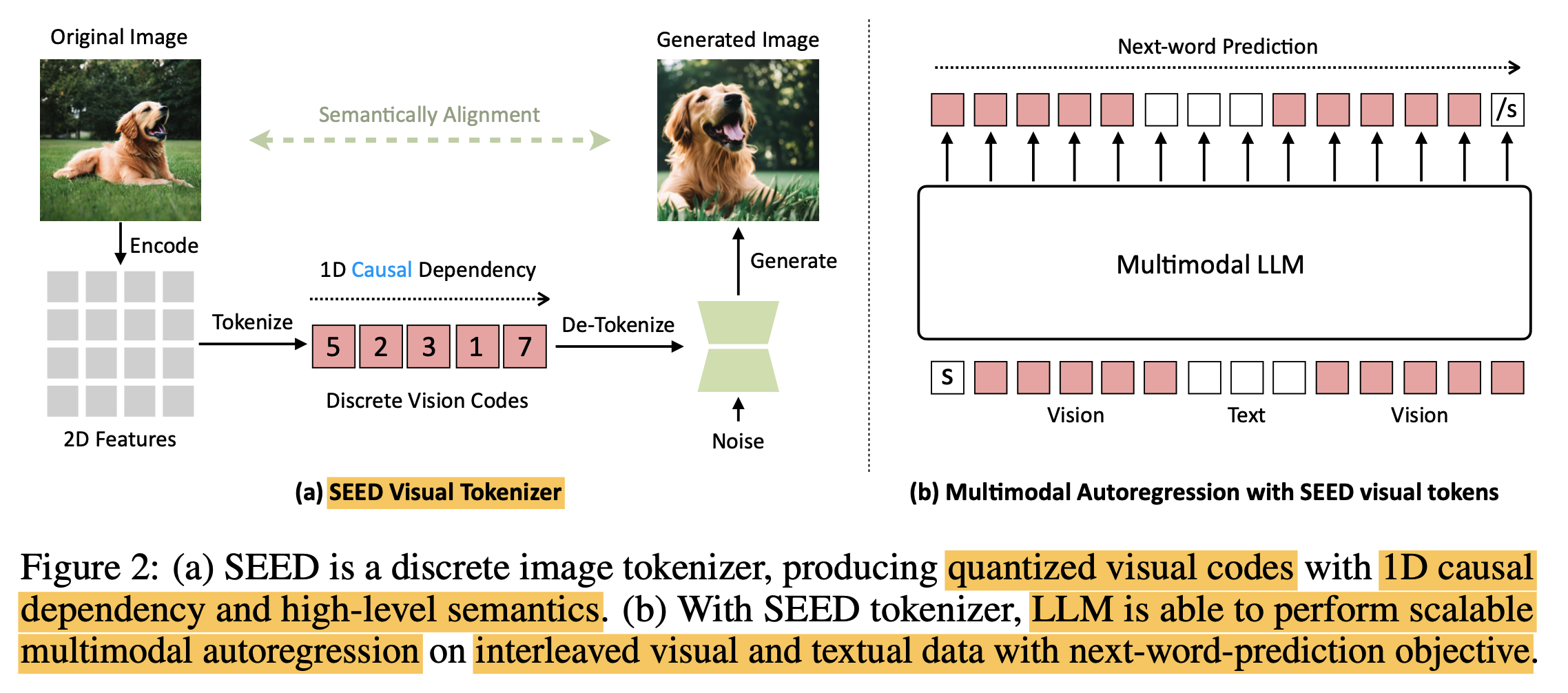
-
2. Contribution
- LLM의 token은 modality에 상관없이 high-level semantic을 capture해야 한다는 insight를 가지고 SEED라는 Advanced image tokenizer를 제안함
- LLM의 학습 레시피를 그대로 사용하기 위해서 visual tokenizer가 high-semantic token을 추출하는건 필수적
- Multi-modal generation & understanding을 성공적으로 수행하는 통합된 framework인 SEED-LLaMa를 제안함.
- T2I, I2T 등 다양한 Multi-modal task에서 좋은 성능을 내며, Multi-turn In-context understanding & generation 능력을 갖음
3. SEED-LLaMa
-
Overall architecture
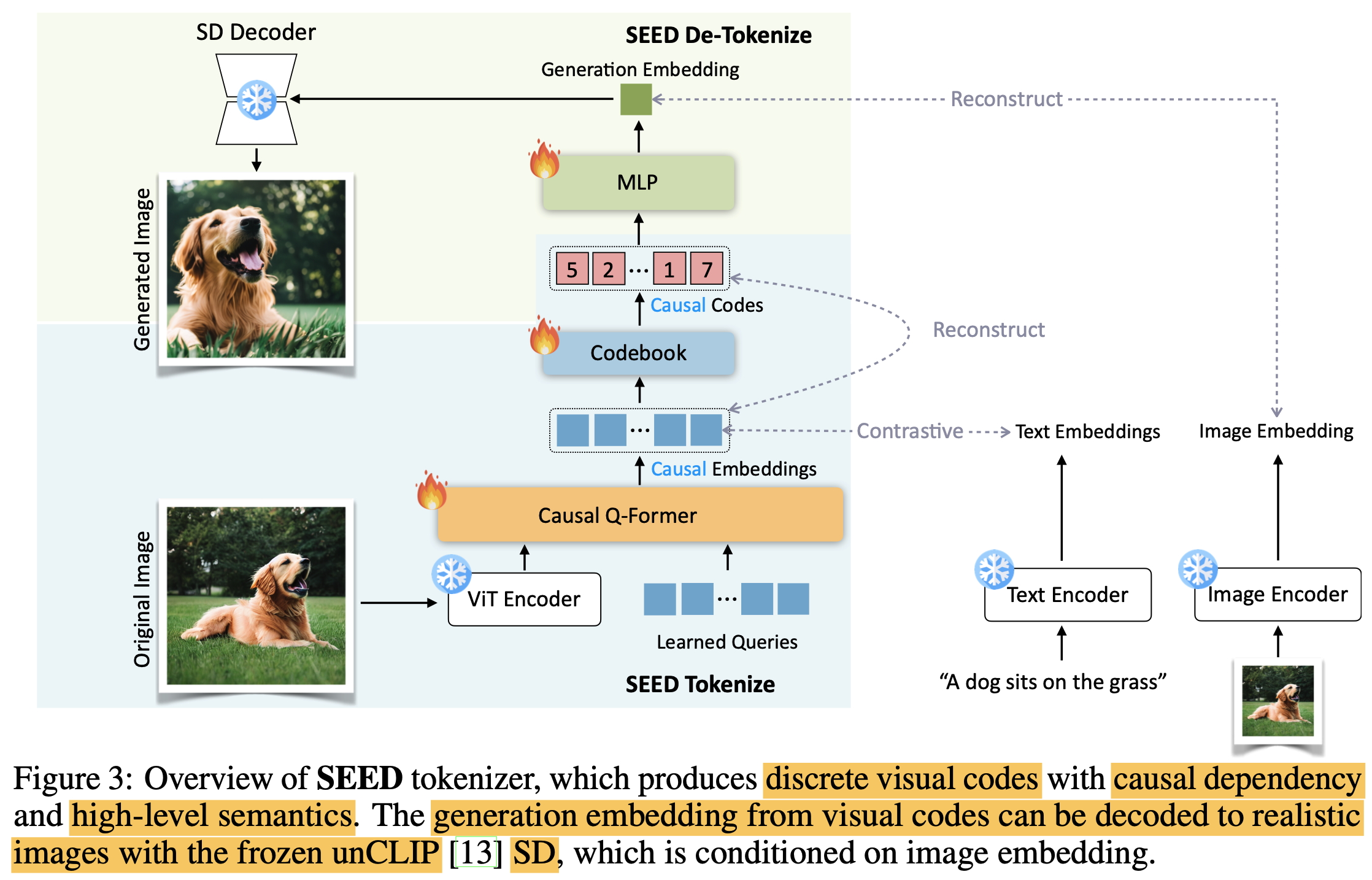
3.1 SEED tokenizer의 구성
-
ViT encoder $\to$ Blip-2 것 활용
- Input : $3 \times 224 \times 224$의 이미지
- Output: $P^2 \times D$의 visual feature
-
Causal Q-Former: ViT visual feature의 visual token 갯수를 줄여 주고, 압축하는 역할 $\to$ Blip-2 것 활용
- Input: $P^2 \times D$의 visual feature
- Output: $32 \times D$ 로 압축된 causal embedding
-
VQ Codebook: Continuous Causal embedding 값을 high-level semantic을 갖는 K개의 discretized codebook로 mapping하는 역할
- Input: $32 \times D$ 로 압축된 causal embedding
- Output: $32 \times D$ 로 압축된 discretized causal embedding
-
MLP: Image를 생성하기 위해 unCLIP-SD의 text prompt가 embedding되는 latent space로 mapping하는 역할 (1 token)
- Input: Codebook의 discretized causal embedding 32개 중 1개의 token $1 \times D$
- Output: unCLIP-SD의 text latent space로 mapping된 generation embedding $1 \times D$
-
UNet decoder $\to$ unCLIP SM 것 활용
- Input: generation embedding $1 \times D$
-
Output: 생성된 Image $3 \times 224 \times 224$
-
Training
I. Causal Q-Former
- 256개의 patch를 32개의 learnable query와 cross attention시켜, 이미지 내의 visual feature를 추출하도록 learnable query를 학습
- Blip-2 Q-former를 initial weight로 활용
- Contrastive Loss를 적용하여 Image를 넣고 생성된 causal embedding이 text feature와 최대한 유사해지도록 학습
- Uni-directional Attention: 기존 Q-Former와 다르면서 LLM과 유사하게 Causal Attention으로 구성
II. Visual Tokenizer & De-tokenize
- Causal embedding: Multi-layer Transformer로 된 decoder를 사용하여 discrete code가 causal embedding을 복원하도록 학습 (MSE Loss)
- Generation embedding: MLP를 통해 1개의 token에 대해 frozen unCLIP-SD의 text latent space를 복원하도록 학습 (MSE Loss)
- Codebook
- Size $K=8192$
- Random initialized
- 256개의 patch를 32개의 learnable query와 cross attention시켜, 이미지 내의 visual feature를 추출하도록 learnable query를 학습
3.2 SEED-LLaMa
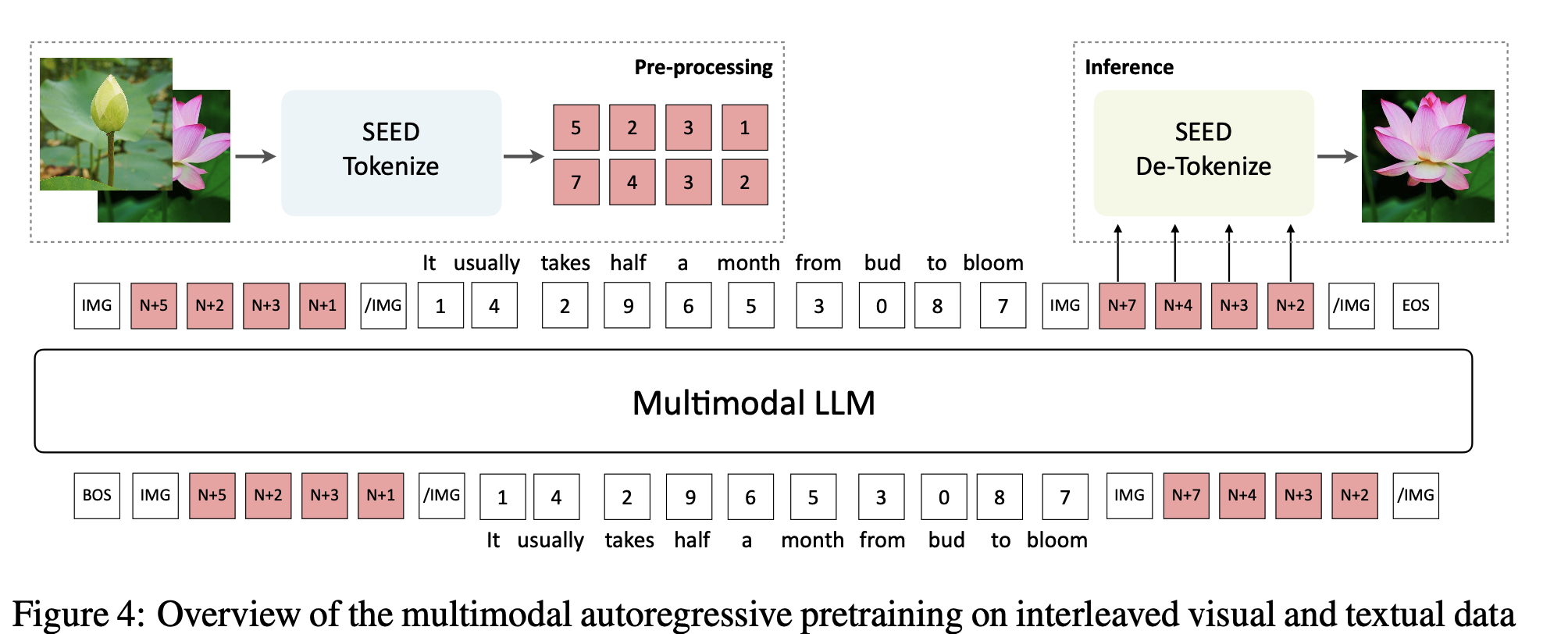
-
Multi-modal Pretraining
-
Interleaved visual & textual data로 구성된 multi-modal prompt를 활용하여 Next-word prediction loss로 학습

- $u_i$: visual or textual token
-
Pretrained LLM (Vicuna-7B/13B or LLaMa-2 7B/13B)를 활용
-
Visual codebook 8192개를 LLM vocabulary에 추가
-
학습 전략
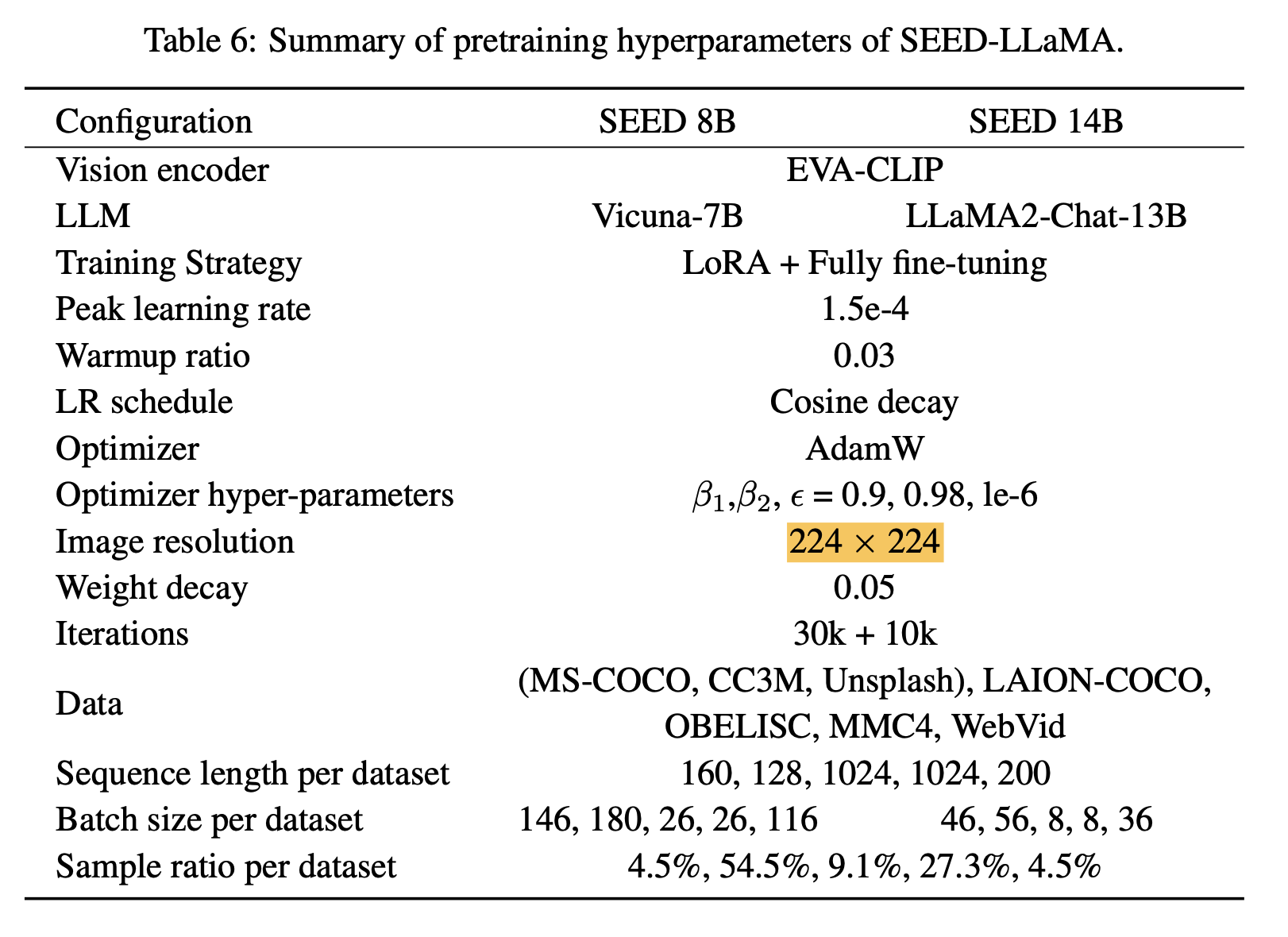
- 초기에 visual codebook이 추가되었기 때문에 Embedding layer (visual encoder)랑 LLM-LoRA로 학습
- 초기 학습 이후, LLM-LoRA로 학습된 weight는 LLM으로 merge하고, LLM만 full-finetuning (embedding layer는 freeze하는게 안정적으로 학습됨)
-
학습 데이터
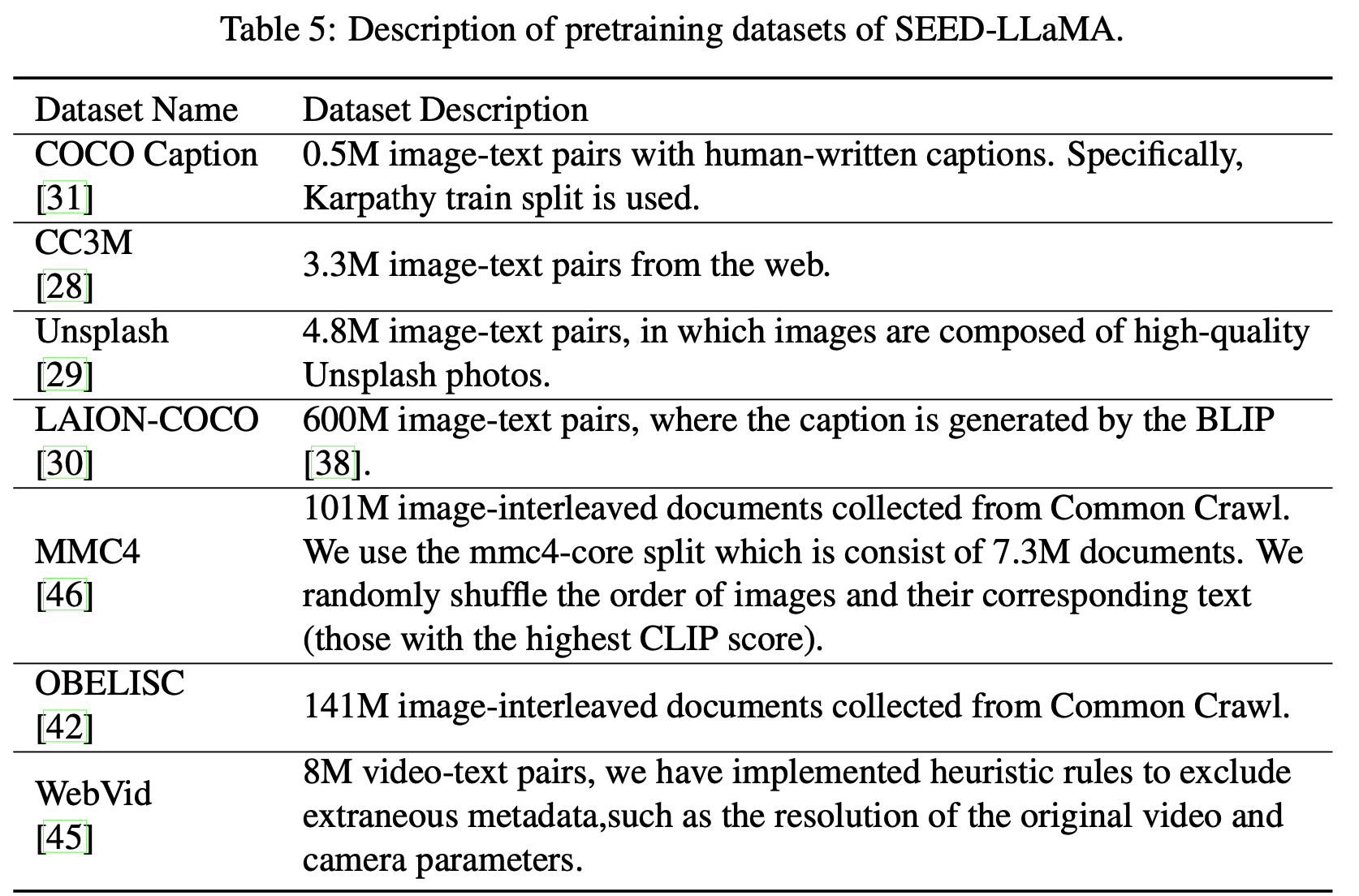
-
학습 시간: Vicuna-7B 기준 A100-40G Gpu 64대로 144시간 소요 (우리 8대 기준 24일)
-
-
Multi-modal Instruction Tuning
-
학습 데이터
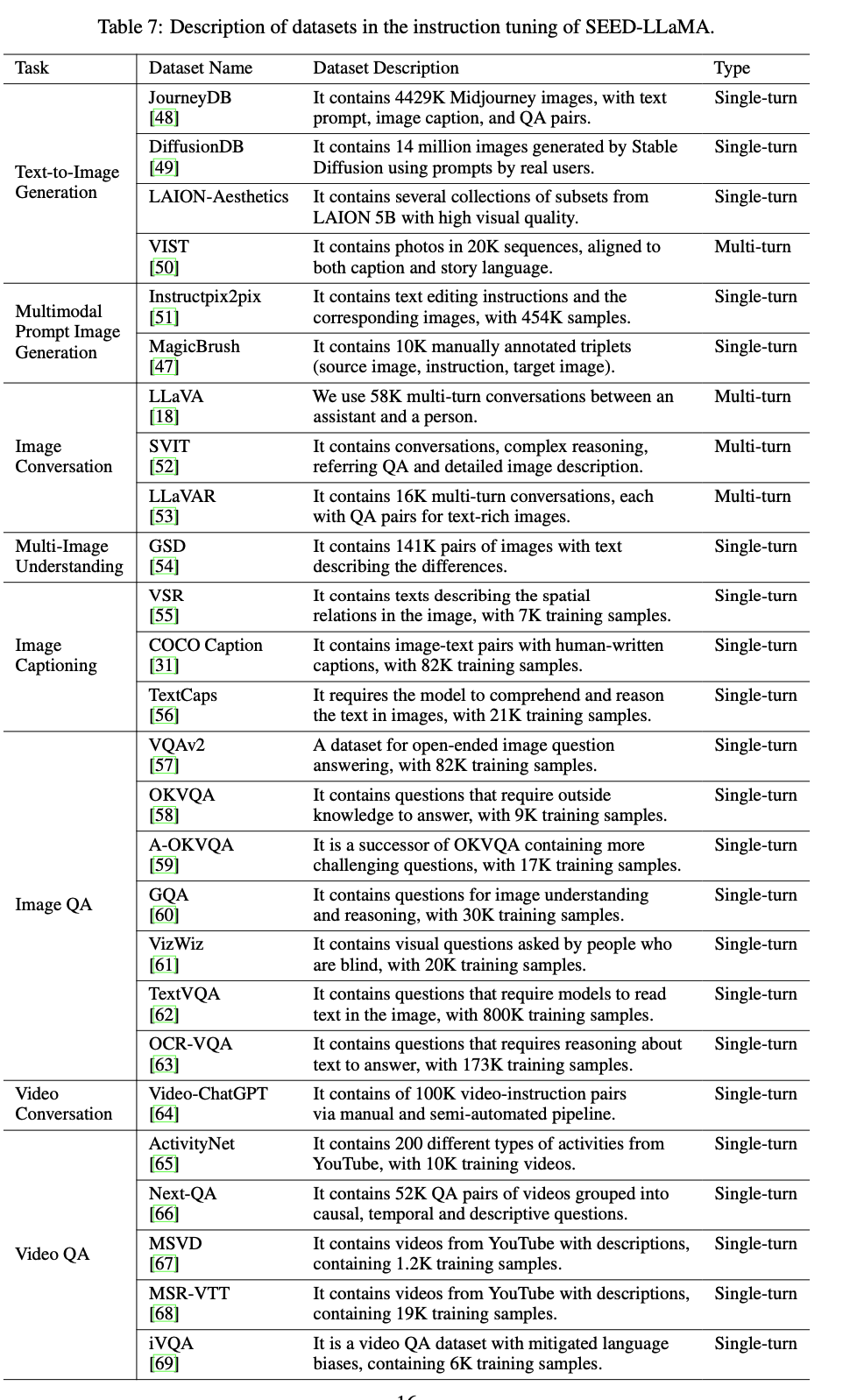
-
템플릿
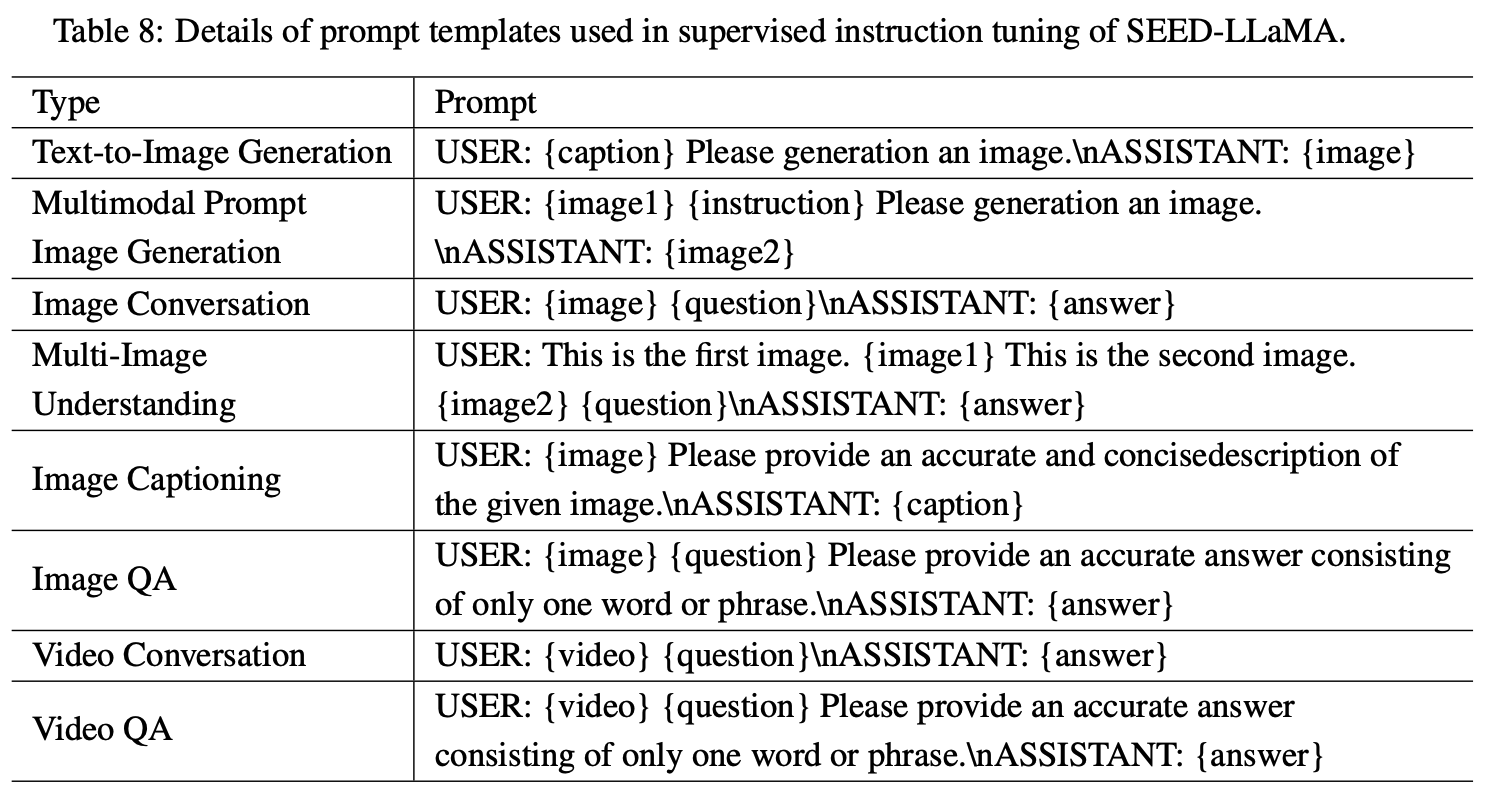
-
학습 시간
- SEED-LLaMA-8B 기준 A100-80G 32대로 16시간 (우리 8대 기준 64시간)
-
4. Experiments
-
Causal Embedding 평가 기준
- Image-Text retrieval
- COCO, Flickr30K (Recall@K)
- 공평한 비교를 위해 Blip-2의 ITM re-rank module을 제거함
- COCO, Flickr30K (Recall@K)
- Image-Text retrieval
-
Causal Embedding 결과
- Text-to-Image & Image-to-Text Retrieval

-
Image Generation (Clip-Similarity score)
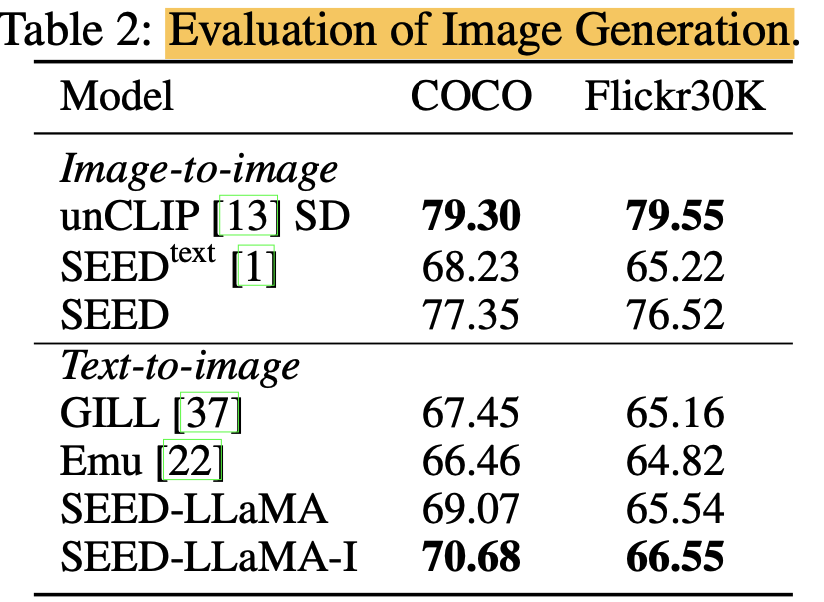

-
SEED-LLaMa
-
Understanding tasks
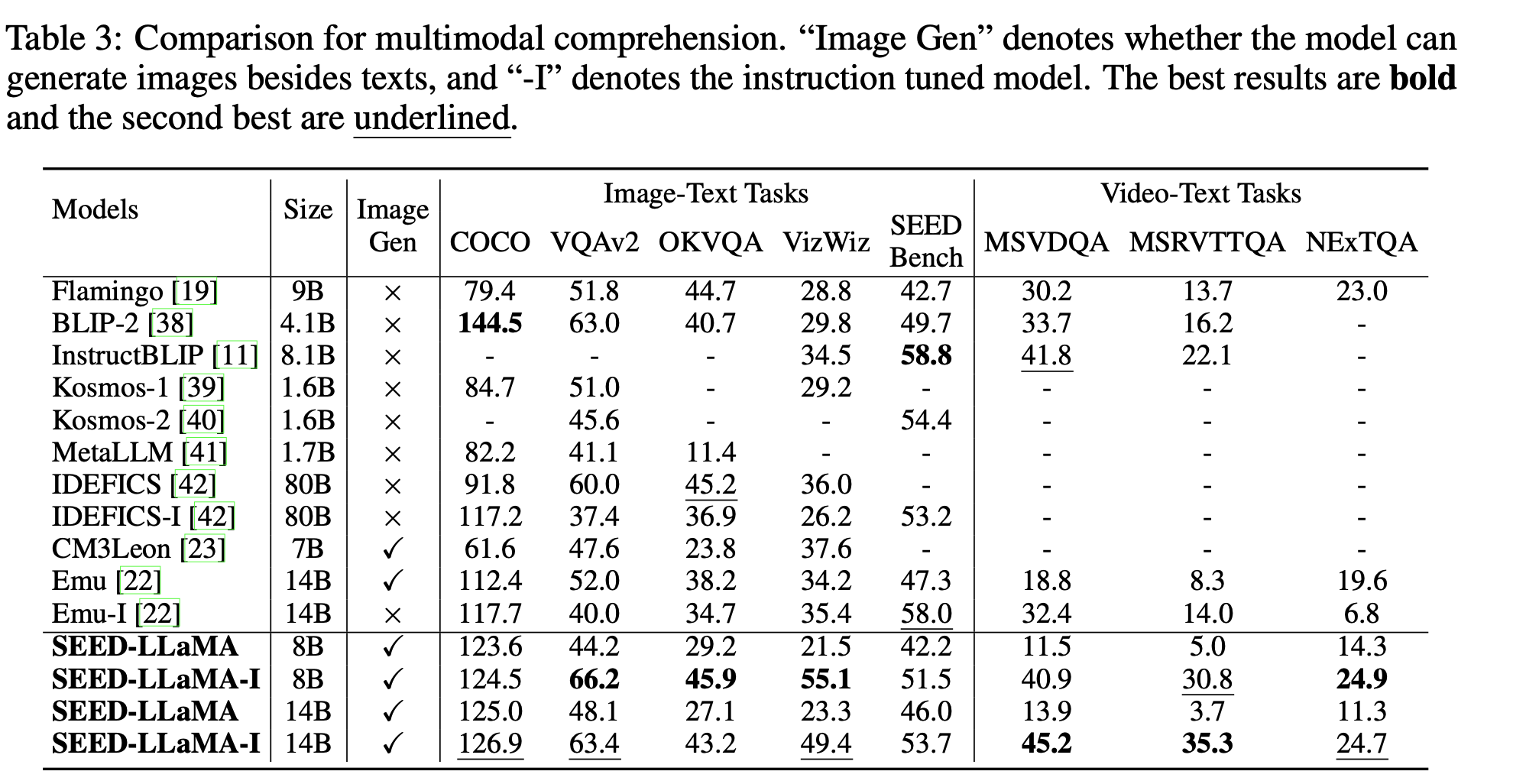
-
Generation tasks

-
Emergent Ablility
-
Multi-turn In-context Multimodal Generation
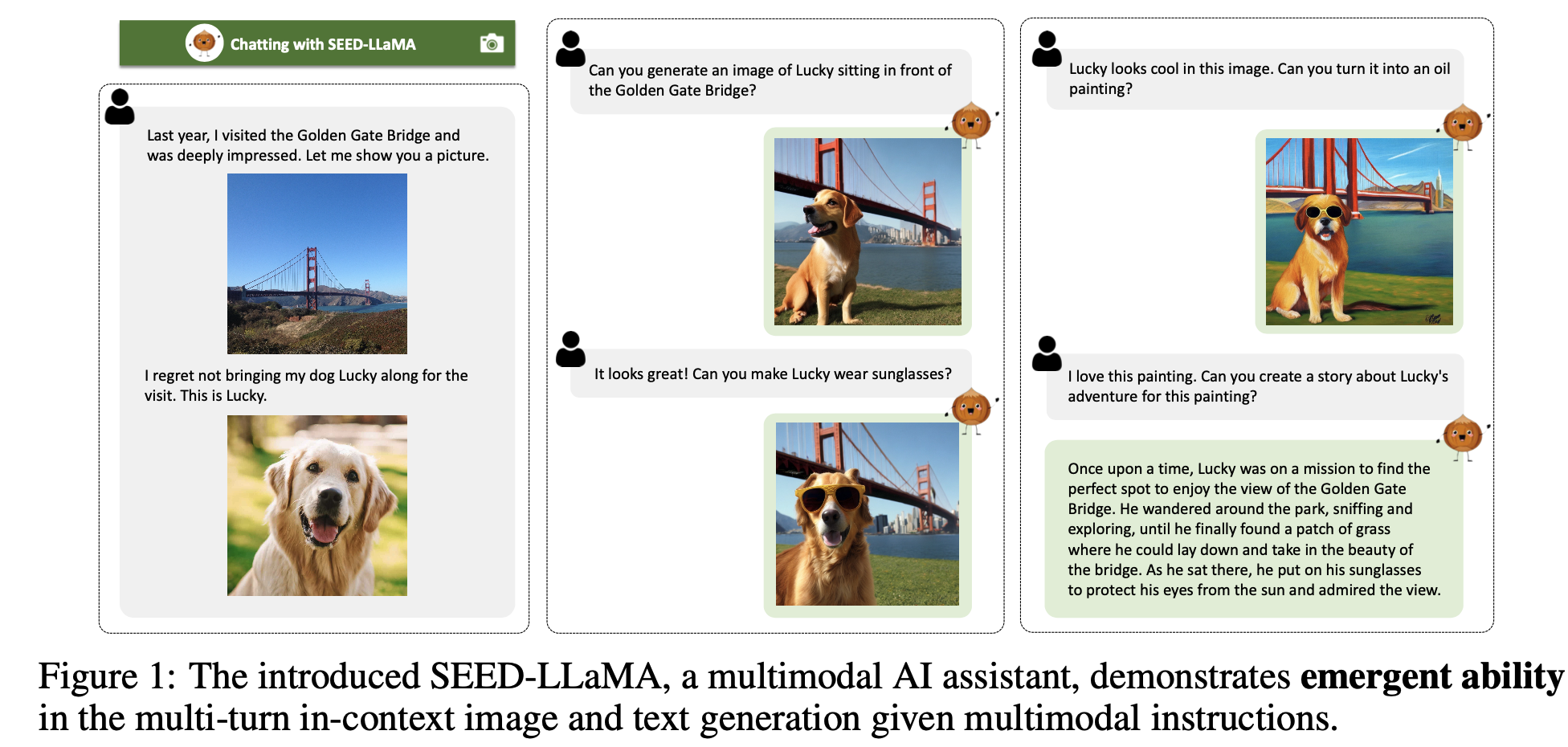
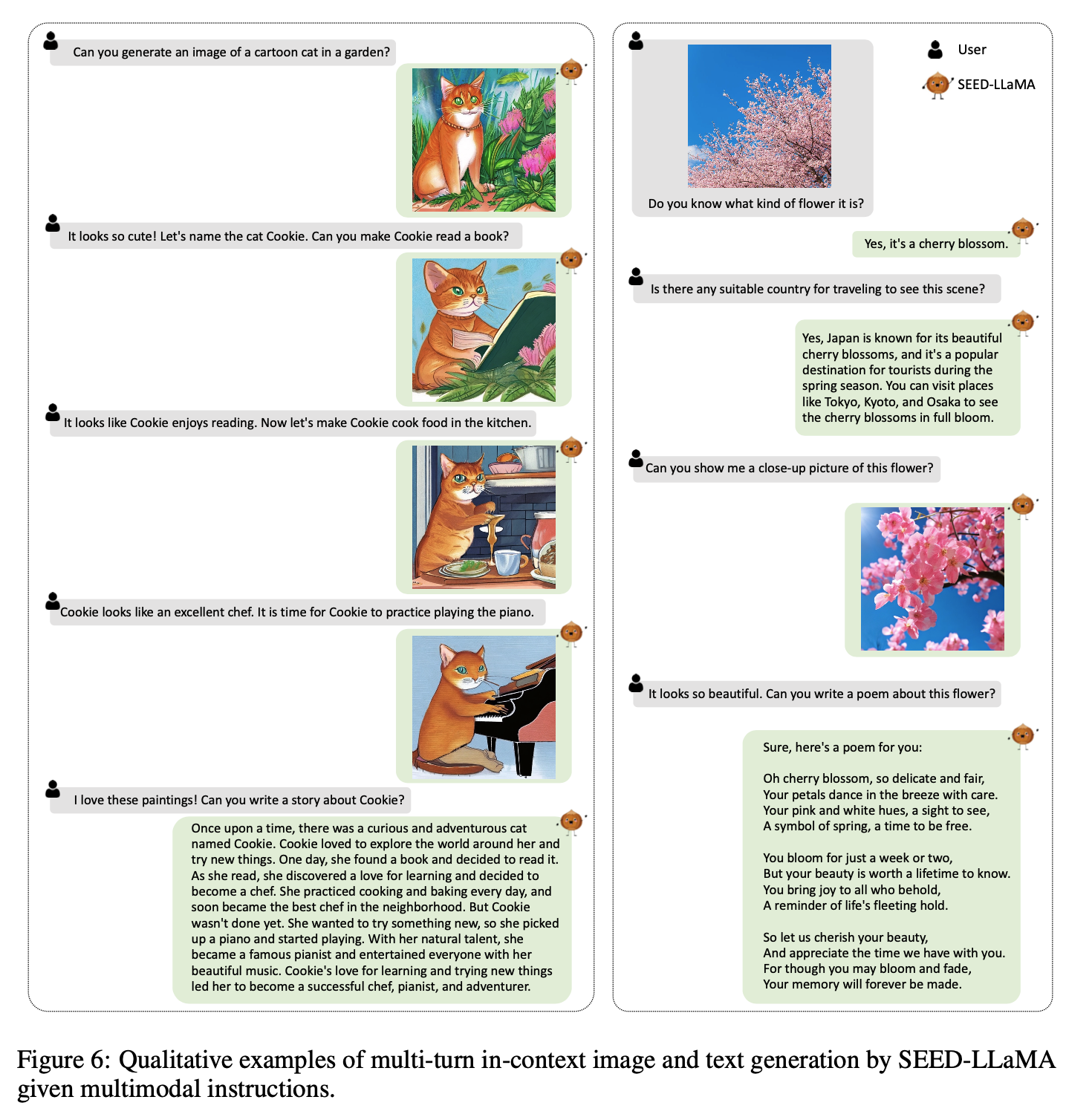
-
Composition Image Generation (Stylized Image Generation, Image Blending, Multimodal Composition, In-Context Generation)
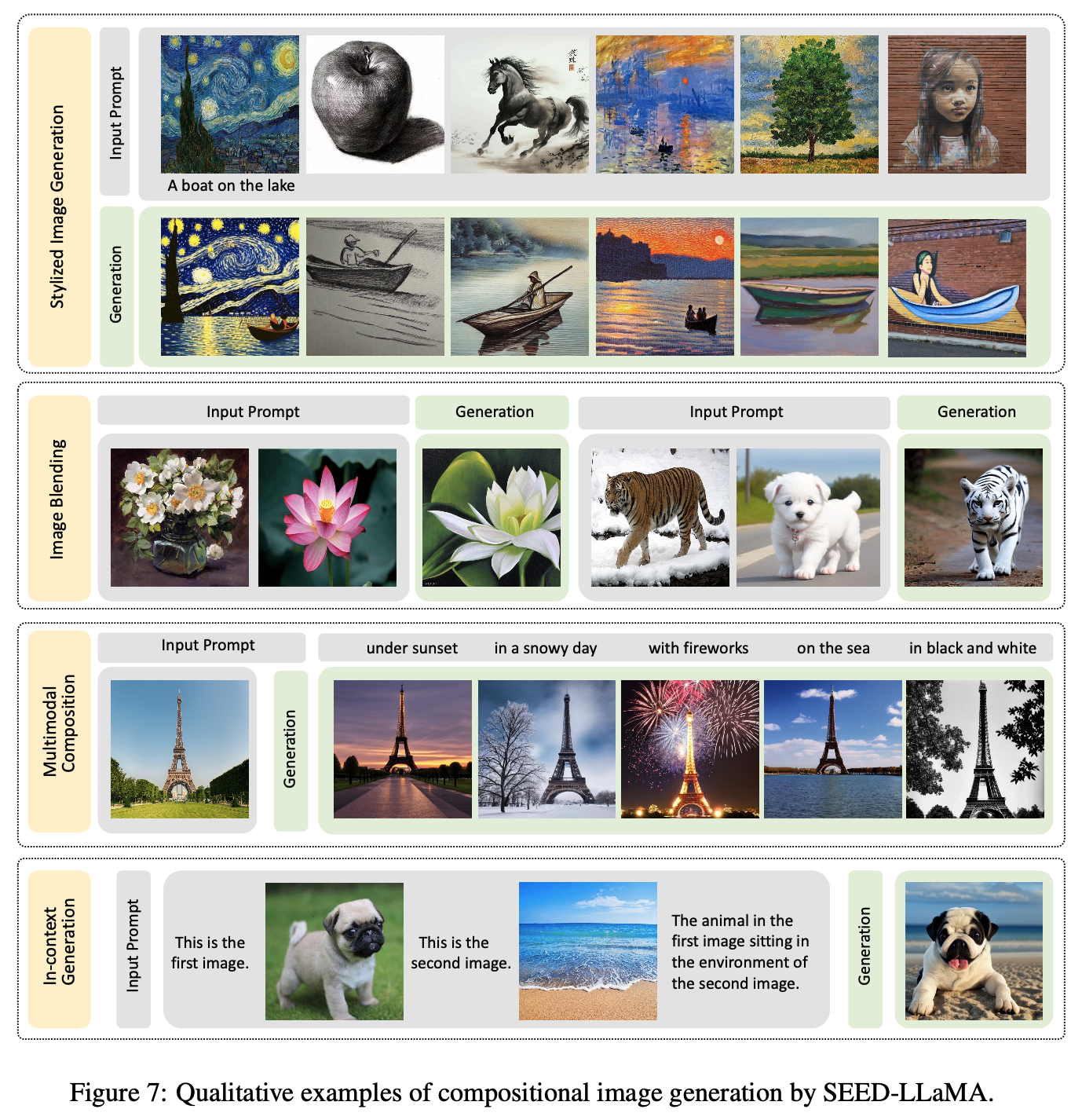
-
-
-
Ablation Study
-
Causal Visual codes vs Bilateral Visual codes
- Bilateral의 경우 5K caption 중 2134개만 성공적으로 이미지를 생성 했으나 $\to$ 32개의 token이 생성되지 않아 문제되는 case가 많음
- Causal의 경우 5K caption 중 4997개를 성공적으로 이미지를 생성함 $\to$ non-causal은 unstable 모델 성능을 냄
-
Seed-LLama pretraining
-
LoRA + Fullfinetuning이 LoRA보다 좋음 (embedding layer는 freeze)

-
-